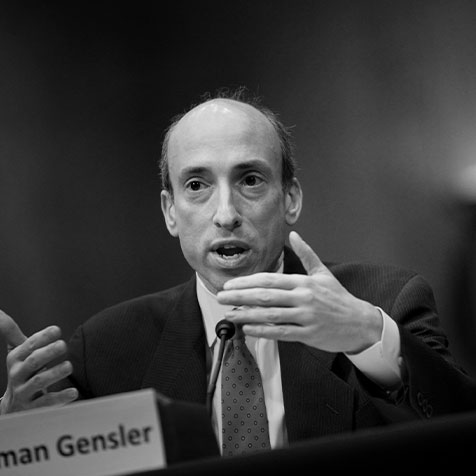Loading component...
At a glance
- Decentralised finance (DeFi) is a growing parallel financial world that includes transactions of financial products, exchanges and insurance that take place on the Ethereum blockchain.
- In global terms, the DeFi sector is still a small one, but its rapid growth over the past two years is attracting large crypto investors.
- As the sector continues to evolve and grow in complexity, traditional banks have the opportunity to leverage their well-recognised brands to remove some of the technical difficulties and knowledge risks associated with DeFi.
By Rachel Williamson
DeFi is a parallel financial world of exchanges, insurance, lending and other financial products that take place largely on the Ethereum blockchain. It replaces financial middlemen like stock exchanges and banks with software programs called “smart contracts” that automate many routine steps.
DeFi’s attraction for consumers lies partly in the significantly higher yields on offer, as compared to its traditional counterparts. As a growth industry, the capital returns are Apple-sized – industry “godfather” Synthetix, one of the fastest growing DeFi projects or “protocols”, more than tripled in value in one month in early 2021, while lender Maple Finance launched in May 2021 with a loan pool of US$17 million (A$23 million), which by October had grown to US$217 million (A$301 million).
Such growth is attracting a new wave of serious crypto investors like Apollo Capital and Paradigm. In October, French investment bank Société Générale proposed a bond token for use on MakerDAO, one of the first widely used DeFi lending platforms.
Despite its rapid growth, the DeFi sector is still tiny in global terms. DeFi tokens have a total market cap of about US$130 billion (A$172 billion), while the total value of all DeFi contracts is about US$195 billion (A$270 billion).
Investors who have been burned by crypto experiments like the initial coin offering boom and bust of 2017-2018 are up against some real challenges. For every skyrocketing success, there is a failure or a scam, such as YAM Finance, which launched in 2020 without having audited the code behind the protocol, only for a bug to torpedo the token value.
In the meantime, regulators are scrambling to keep up, trying to make old school rules fit the new world of DeFi finance.
The internet of money
DeFi works through software programs called “smart contracts” that automatically execute the terms of a deal – for example, selling collateral if a borrower doesn’t pay back their loan, or paying interest, quoted as annual percentage rates or yields, to investors.
Unlike a traditional fund, where investors hand over their cash and receive quarterly reports, DeFi users retain full custody of their assets and decision-making power, and know precisely where their assets go and with whom.
Where traditional finance requires different types of technology, from bank accounts to accounting software and brokers, with DeFi everything happens on one layer of blockchain infrastructure. A crypto wallet is the only portal needed to access DeFi services.
Systemic risk
DeFi advocates like Chloe White, managing director of digital assets advisory Genesis Block, believe this kind of “extreme financial” innovation, combined with the fragmentation inherent in a decentralised system, could provide the foundation for preventing systemic threats like the global financial crisis.
“We can potentially de-risk some aspects of the financial market, in terms of individual players in the market, but also the market systemically as a whole,” she says.

“I’m interested in whether DeFi will drive the creation of fundamentally new structures for financial markets, capital markets and what new financial products and services could emerge.”
Andrew Han FCPA, director of business research at US-based digital asset custody and settlement platform Fireblocks whose Asia-Pacific headquarters are based in Singapore, says DeFi allows developers to build inherent governance standards into smart contracts.
This introduces a unique opportunity to bring transparency to financial products and services, such as around the credit or risk rating of underlying assets.
“If we are able to build into the smart contract adequate checks of the actual quality of the underlying assets, then you should be able to bring a level of confidence and stability to the markets and higher integrity to the issuing of structured products involving these digital assets,” he says.
Trust is the next big thing
The DeFi sector has, to date, been based on the distributed ledger principle of “trustlessness”, whereby users replace trust in an economic relationship with an algorithm.
DeFi is oversaturated with trustless applications, says Sidney Powell, CEO and co-founder of Maple Finance. This includes over-collateralised lending, whereby borrowers put up assets worth two or three times the loan value, as well as decentralised exchanges and yield aggregators, which put your money into a smart contract that searches for the best yield from other smart contracts.
“I think the opportunities are in areas where there is a bit of human communication in transacting or using the protocol,” Powell says.
"I'm interested in whether DeFi will drive the creation of fundamentally new structures for financial markets, capital markets and what new financial products and services could emerge."
Maple’s model, which requires no collateral when it matches lenders with institutional borrowers, requires applications to be vetted and underwritten by experienced humans rather than code. From that point on, however, it is based on transparency – lenders monitor who is borrowing, the current lending strategy and pool performance in real time. While the paperwork is replaced by the blockchain, master loan agreements signed with borrowers mean the debt is enforceable in a traditional court of law.
White says there is an opportunity for traditional financiers, such as banks, to leverage their brands in order to solve another challenge facing DeFi today – the sheer complexity of the system.
As of October 2021, only 1 per cent of all Ethereum addresses interacted with DeFi, suggesting that DeFi is beyond the ability of the average Ethereum user.
Major banks “can leverage their trusted brands to compete as a familiar interface between a person or business and a decentralised protocol, and remove some of these technical difficulties and knowledge risks that come with DeFi”, White says.
Hacks, fraud and theft

DeFi, which has only been around since 2018, also lacks strong security controls.
In the first seven months of 2021 alone, users lost US$681 million (A$903 million) to fraud, hacks and theft, while DeFi-related fraud accounted for 54 per cent of all major crypto fraud, as compared to only 3 per cent in all of 2020.
External hacks make up about 76 per cent of DeFi fraud, with the remainder made up of insider “rug pulls”, where developers run off with the users’ cash.
Anouk Pinchetti, head of education with Ethitech Australia and member of CPA Australia’s Centre of Excellence for Digital Transformation, says DeFi users should be vigilant. “The contracts that you are trusting with your money may not be secure, and 99.999 per cent of people can’t make that assessment,” he says.
“There are some pretty big cases of fraud within large financial institutions that regulation didn’t protect us against, but it’s a lot easier for scammers to set up a smart contract than it is for them to run a bank.”
A new world of risk
As in traditional finance, knowledge risk – the idea that you need to be able to understand the product your money is in – exists, but DeFi adds a layer of technology risk, too.
A bug, even in audited code, can ruin investors or DeFi protocols, as seen when Compound, a platform that lets users lend cryptocurrencies and earn a return, upgraded its protocol in October and a bug issued nearly US$90 million (A$119 million) worth of tokens accidentally. The founder was left begging recipients to return them.
"If you can't get the basics right and account for it like a financial instrument... then everything that flows from it, like interest type returns, is on the wrong system."
However, even a smart contract working exactly as intended could still present a technology problem. For example, in March 2020 the value of Ethereum tokens crashed, which caused smart contracts on MakerDAO to sell off borrowers’ collateral. Without a circuit breaker, the automated contracts liquidated some 1200 loans that suddenly became under-collateralised, while at the same time a clogged Ethereum network meant borrowers weren’t able to top up their collateral ahead of the sell-off.
Despite these teething issues, White says the industry is working to solve its own problems.
“You can now access smart contracts where there’s insurance built into them, so the recourse itself is also managed in a decentralised way,” she says.
The taxman cometh

DeFi success stories like Synthetix and Maple are enticing more money into DeFi every day, but there is one hard reality that hasn’t yet been resolved in Australia – namely, tax.
“We don’t have an accounting standard as such, specifically, for cryptocurrencies,” says David Hardidge FCPA, director of technical and treasury products with the Queensland Audit Office and member of CPA Australia’s Centre of Excellence for Digital Transformation.
In 2019, the International Financial Reporting Standards Foundation said cryptocurrencies should largely be considered intangible assets, but that doesn’t work for, say, returns from a DeFi loan pool. “If you can’t get the basics right and account for it like a financial instrument – maybe not cash or money, but something that’s very similar – then everything that flows from it, like interest type returns, is on the wrong system,” Hardidge says.
The debate over how to tax these parallel financial instruments continues, and feeds into a parallel debate over how they should be regulated.
According to Powell, both traditional finance and DeFi companies would greatly benefit from regulatory clarity. The former is stuck on the sidelines as it struggles to find ways to use DeFi that are compliant with existing laws and guidelines, while the latter are being hit with investigations, like that into Uniswap Labs by the US Securities Exchange Commission (SEC).
Powell would like to see some safe harbours from global regulators – for example a developer team working on a project not being considered as the issuer of a security.
Meanwhile, regulators are most concerned with the Know Your Customer (KYC) conditions, especially, as fears rise that DeFi is the perfect tool for money laundering. Indeed, in Australia all digital currency exchange providers must register with financial intelligence agency AUSTRAC.
Fractured approach
Whether many DeFi tokens fall under securities’ laws is currently a country-by-country determination.
In the UK, the Financial Conduct Authority has set out clear categories for which tokens are subject to its securities law and which are not.

In the US, SEC chair Gary Gensler has been firm that crypto companies need to proactively seek oversight from regulators.
In Australia, chapter seven of the Corporations Act gives mixed messages – a DeFi protocol can be a managed investment scheme, an equity or a derivative.
According to White, this is not fit for purpose for DeFi protocols, which often lack even the most basic regulatory requirements, such as the registered company’s physical street address.
“Singapore, the UK, countries within the EU and the EU itself are further ahead of where we are in terms of digital assets regulation, and Australia has been losing businesses and investment to these other jurisdictions,” White says.
“There’s a case that Australia needs to remain competitive. We can’t afford to leave this for too long. Otherwise, we end up in a situation where we will become an importer of the technology.”

